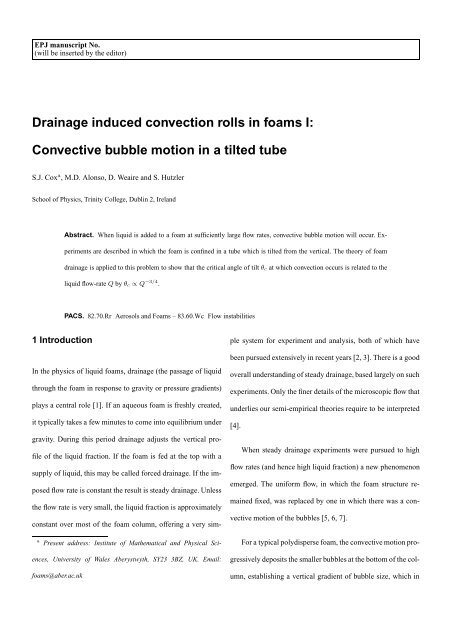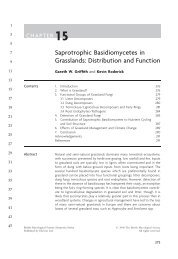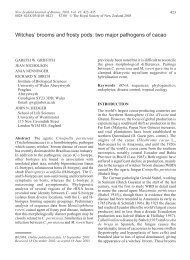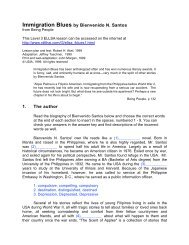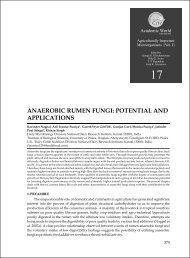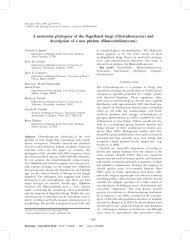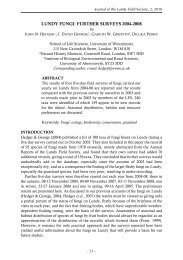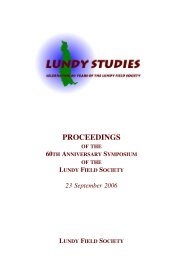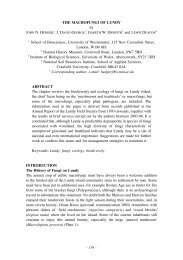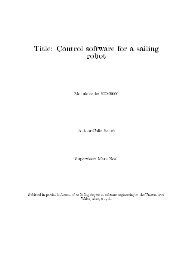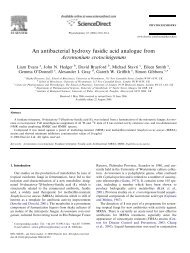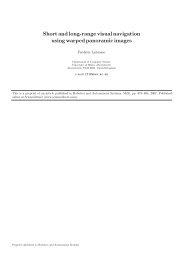Drainage induced convection rolls in foams I - The Aberystwyth ...
Drainage induced convection rolls in foams I - The Aberystwyth ...
Drainage induced convection rolls in foams I - The Aberystwyth ...
Create successful ePaper yourself
Turn your PDF publications into a flip-book with our unique Google optimized e-Paper software.
EPJ manuscript No.<br />
(will be <strong>in</strong>serted by the editor)<br />
<strong>Dra<strong>in</strong>age</strong> <strong><strong>in</strong>duced</strong> <strong>convection</strong> <strong>rolls</strong> <strong>in</strong> <strong>foams</strong> I:<br />
Convective bubble motion <strong>in</strong> a tilted tube<br />
S.J. Cox a , M.D. Alonso, D. Weaire and S. Hutzler<br />
School of Physics, Tr<strong>in</strong>ity College, Dubl<strong>in</strong> 2, Ireland<br />
1 Introduction<br />
Abstract. When liquid is added to a foam at sufficiently large flow rates, convective bubble motion will occur. Ex-<br />
periments are described <strong>in</strong> which the foam is conf<strong>in</strong>ed <strong>in</strong> a tube which is tilted from the vertical. <strong>The</strong> theory of foam<br />
dra<strong>in</strong>age is applied to this problem to show that the critical angle of tilt θc at which <strong>convection</strong> occurs is related to the<br />
liquid flow-rate Q by θc ∝ Q −3/4 .<br />
PACS. 82.70.Rr Aerosols and Foams – 83.60.Wc Flow <strong>in</strong>stabilities<br />
In the physics of liquid <strong>foams</strong>, dra<strong>in</strong>age (the passage of liquid<br />
through the foam <strong>in</strong> response to gravity or pressure gradients)<br />
plays a central role [1]. If an aqueous foam is freshly created,<br />
it typically takes a few m<strong>in</strong>utes to come <strong>in</strong>to equilibrium under<br />
gravity. Dur<strong>in</strong>g this period dra<strong>in</strong>age adjusts the vertical pro-<br />
file of the liquid fraction. If the foam is fed at the top with a<br />
supply of liquid, this may be called forced dra<strong>in</strong>age. If the im-<br />
posed flow rate is constant the result is steady dra<strong>in</strong>age. Unless<br />
the flow rate is very small, the liquid fraction is approximately<br />
constant over most of the foam column, offer<strong>in</strong>g a very sim-<br />
a Present address: Institute of Mathematical and Physical Sci-<br />
ences, University of Wales <strong>Aberystwyth</strong>, SY23 3BZ, UK. Email:<br />
<strong>foams</strong>@aber.ac.uk<br />
ple system for experiment and analysis, both of which have<br />
been pursued extensively <strong>in</strong> recent years [2, 3]. <strong>The</strong>re is a good<br />
overall understand<strong>in</strong>g of steady dra<strong>in</strong>age, based largely on such<br />
experiments. Only the f<strong>in</strong>er details of the microscopic flow that<br />
underlies our semi-empirical theories require to be <strong>in</strong>terpreted<br />
[4].<br />
When steady dra<strong>in</strong>age experiments were pursued to high<br />
flow rates (and hence high liquid fraction) a new phenomenon<br />
emerged. <strong>The</strong> uniform flow, <strong>in</strong> which the foam structure re-<br />
ma<strong>in</strong>ed fixed, was replaced by one <strong>in</strong> which there was a con-<br />
vective motion of the bubbles [5, 6, 7].<br />
For a typical polydisperse foam, the convective motion pro-<br />
gressively deposits the smaller bubbles at the bottom of the col-<br />
umn, establish<strong>in</strong>g a vertical gradient of bubble size, which <strong>in</strong>
2 Cox, Alonso, Weaire, Hutzler: Convective bubble motion <strong>in</strong> a tilted tube<br />
turn suppresses the motion [8]. For a monodisperse foam, the<br />
convective motion cont<strong>in</strong>ues <strong>in</strong>def<strong>in</strong>itely, so this is the usual<br />
objective of study <strong>in</strong> attempts to understand <strong>convection</strong>.<br />
In the present paper we present a variation of the now fa-<br />
miliar experiment: the column is tilted away from the vertical.<br />
With such a tilt, <strong>convection</strong> is observed even at quite small flow<br />
rates. We are able to account for the <strong>convection</strong> <strong>in</strong> this case <strong>in</strong><br />
terms of a simple theory <strong>in</strong> which it is seen to be driven by<br />
the transverse variation (across the column) of liquid density,<br />
<strong>in</strong> equilibrium.<br />
This limited success may offer <strong>in</strong>sight and confidence that<br />
the spontaneous convective <strong>in</strong>stability <strong>in</strong> a vertical column can<br />
be adequately expla<strong>in</strong>ed <strong>in</strong> similar terms. We shall return to that<br />
objective <strong>in</strong> a further paper.<br />
<strong>The</strong> behaviour of the dra<strong>in</strong><strong>in</strong>g tilted foam is rem<strong>in</strong>iscient of<br />
the Boycott effect [9], which describes how the sedimentation<br />
of particles suspended <strong>in</strong> a fluid is faster <strong>in</strong> a tilted tube than<br />
<strong>in</strong> a vertical one. <strong>The</strong> explanation of this phenomenon [10] is<br />
that <strong>in</strong> the vertical tube the particles have to move aga<strong>in</strong>st the<br />
static fluid. When the tube is tilted, the concentration of parti-<br />
cles below the axis of the tube grows and the fluid rises above<br />
the axis. <strong>The</strong> <strong>convection</strong> produced helps the particles to sedi-<br />
ment faster. An analogous situation has been found <strong>in</strong> granular<br />
materials where the flow of gra<strong>in</strong>s out of a tube is fastest at<br />
angles between 30 ◦ and 45 ◦ degrees from the vertical [11].<br />
However, although close analogies have been found <strong>in</strong> many<br />
aspects of the behaviour of <strong>foams</strong> and granular materials, it is<br />
important to stress that there is no trivial relationship between<br />
them.<br />
ˆy<br />
Y<br />
Flow rate<br />
Z<br />
θ<br />
Surfactant solution<br />
gravity<br />
Fig. 1. A sketch of the convective roll <strong>in</strong> a tilted tube, show<strong>in</strong>g the<br />
(Y,Z) coord<strong>in</strong>ate system used <strong>in</strong> the analysis and the ˆy coord<strong>in</strong>ate<br />
around the cyl<strong>in</strong>der. <strong>The</strong> dashed central l<strong>in</strong>e is a reference show<strong>in</strong>g the<br />
central axis of the tube. <strong>The</strong> arrows show the sense of the motion of the<br />
bubbles. Fluid dra<strong>in</strong><strong>in</strong>g <strong>in</strong>to and through the foam moves preferably <strong>in</strong><br />
the vertical direction, due to gravity.<br />
2 Experimental procedure and observations<br />
A column of foam was created by blow<strong>in</strong>g nitrogen gas through<br />
a syr<strong>in</strong>ge needle <strong>in</strong>to a solution of the commercial detergent<br />
Fairy Liquid, and collect<strong>in</strong>g the bubbles <strong>in</strong> a glass tube. We<br />
used glass tubes with diameter d =2.05 cm and length 35.5 cm.<br />
<strong>The</strong> <strong>foams</strong> were monodisperse with bubble radii of rb =1.55 mm.<br />
A forced dra<strong>in</strong>age experiment was performed by add<strong>in</strong>g<br />
the same surfactant solution at the top us<strong>in</strong>g a Watson-Marlow<br />
505S peristaltic pump, which allows <strong>in</strong>crements of 0.03 ml/s <strong>in</strong><br />
flow rate Q. <strong>The</strong> result was observed for a range of tilt angles<br />
up to 25 ◦ .<br />
<strong>The</strong> bubble motion that is observed is the simple convec-<br />
tive roll <strong>in</strong>dicated <strong>in</strong> figure 1. <strong>The</strong> downward-travell<strong>in</strong>g side
Average velocity of<br />
surface bubbles [cm/s]<br />
0.5<br />
0<br />
-0.5<br />
-1<br />
-1.5<br />
-2<br />
-2.5<br />
Cox, Alonso, Weaire, Hutzler: Convective bubble motion <strong>in</strong> a tilted tube 3<br />
θ = 5 ◦<br />
θ = 7 ◦<br />
θ = 9 ◦<br />
θ = 12 ◦<br />
θ = 15 ◦<br />
θ = 20 ◦<br />
θ = 25 ◦<br />
-1.5 -1 -0.5 0 0.5 1 1.5<br />
Position on surface of tube ˆy [cm]<br />
Fig. 2. <strong>The</strong> velocity of the surface bubbles (each po<strong>in</strong>t represents an<br />
average of six measurements) <strong>in</strong> different positions around the surface<br />
of the tube, with ˆy = − 1<br />
π cm correspond<strong>in</strong>g to the lower boundary<br />
2<br />
of the tube. <strong>The</strong> <strong>in</strong>put flow rate was fixed at Q = 0.408 ml/s. Bubbles<br />
at ˆy = 0 start to move upwards at angles above 12 ◦ . <strong>The</strong> width of<br />
the wet region decreases when the tube is tilted, while the speed of<br />
bubbles above the centrel<strong>in</strong>e is fairly constant at each angle, which is<br />
consistent with the plug flow observed visually. Error bars have been<br />
omitted for clarity.<br />
is visibly “wetter”, that is, of higher liquid fraction, and trav-<br />
els with velocities that are of the order of 1cm/s. <strong>The</strong> upward-<br />
travell<strong>in</strong>g side has a lower velocity of the order of a few mm/s.<br />
Various measurements of surface bubble velocities were made,<br />
confirm<strong>in</strong>g the visual observation that the dry foam undergoes<br />
plug flow, while the wet foam is cont<strong>in</strong>uously sheared (figure<br />
2).<br />
This type of motion has also been observed <strong>in</strong> the case of<br />
the vertical tube, but <strong>in</strong> recent work we have also found a cyl<strong>in</strong>-<br />
drically symmetric form of <strong>convection</strong> <strong>in</strong> which all the surface<br />
bubbles move downwards together and the return motion is <strong>in</strong><br />
the centre of the tube [7].<br />
Average velocity of the bubbles (upwards motion) [cm/s]<br />
4<br />
3.5<br />
3<br />
2.5<br />
2<br />
1.5<br />
1<br />
0.5<br />
flow rate = 1.80 ml/s<br />
flow rate = 1.50 ml/s<br />
flow rate = 1.20 ml/s<br />
flow rate = 1.02 ml/s<br />
flow rate = 0.90 ml/s<br />
flow rate = 0.60 ml/s<br />
flow rate = 0.48 ml/s<br />
flow rate = 0.36 ml/s<br />
flow rate = 0.30 ml/s<br />
0<br />
0 5 10 15<br />
Tilt angle [degrees]<br />
20 25 30<br />
Fig. 3. <strong>The</strong> upward velocity of bubbles <strong>in</strong> the dry foam <strong>in</strong> rela-<br />
tion to the tilt angle θ. <strong>The</strong> data are fitted to the function v(θ) =<br />
vlim tanh((θ−θc)/θ0) and each curve labeled with the fixed flow rate<br />
at which the data were taken. For small angles, an <strong>in</strong>crease <strong>in</strong> θ leads<br />
to an <strong>in</strong>crease <strong>in</strong> velocity. At higher angles, we see that for low flow<br />
rates the velocity reaches a plateau, vlim, while for higher flow rates,<br />
the bubbles slow down slightly. In fitt<strong>in</strong>g the data to the ansatz given <strong>in</strong><br />
(1), we ignore these po<strong>in</strong>ts, which only affects flow rates higher than<br />
about 1 ml/s.<br />
For the present case of the tilted tube, we observe only the<br />
simple roll described above, and for further analysis we char-<br />
acterise it by the velocity of plug flow on the dry, upper, side.<br />
Figure 3 presents data for a range of flow rates. It is evident<br />
that there is <strong>in</strong> each case a critical angle θc below which there<br />
is no <strong>convection</strong>. <strong>The</strong> velocity of <strong>convection</strong> <strong>in</strong>creases rapidly<br />
when the angle is <strong>in</strong>creased from this critical value, and eventu-<br />
ally saturates. Of course this description does not apply <strong>in</strong> full<br />
at higher flow rates, for which the critical angle goes to zero.<br />
<strong>The</strong> three parameter fitt<strong>in</strong>g function<br />
v(θ) = vlim tanh((θ − θc)/θ0) (1)
4 Cox, Alonso, Weaire, Hutzler: Convective bubble motion <strong>in</strong> a tilted tube<br />
Limit<strong>in</strong>g velocity vlim [cm/s]<br />
4<br />
3.5<br />
3<br />
2.5<br />
2<br />
1.5<br />
1<br />
0.5<br />
0<br />
0 0.2 0.4 0.6 0.8 1 1.2 1.4 1.6 1.8<br />
Flow rate Q [ml/s]<br />
Fig. 4. <strong>The</strong> limit velocity vlim reached by the convective roll <strong>in</strong> a tilted<br />
tube varies l<strong>in</strong>early with flow rate. Extracted from the data of figure 3.<br />
was found to be a convenient representation of the data: we<br />
make no claim for this particular analytic form, although the<br />
implied <strong>in</strong>itial l<strong>in</strong>ear <strong>in</strong>crease of v(θ) seems reasonable.<br />
In this way we reduce the data to two key dependencies,<br />
those of limit<strong>in</strong>g velocity vlim and critical angle θc on flow rate<br />
Q. <strong>The</strong>se are shown <strong>in</strong> figures 4 and 5. <strong>The</strong> limit<strong>in</strong>g velocity is<br />
l<strong>in</strong>ear <strong>in</strong> flow rate, to with<strong>in</strong> a good approximation. <strong>The</strong> critical<br />
angle shows a roughly <strong>in</strong>verse relation with flow rate: the curve<br />
<strong>in</strong>cluded <strong>in</strong> figure 5 is fitted us<strong>in</strong>g<br />
θc = const. × Q −3/4 , (2)<br />
as suggested by the theory which follows. <strong>The</strong> fit appears to be<br />
satisfactory.<br />
It must fail <strong>in</strong> the limit of high Q, s<strong>in</strong>ce there is spontaneous<br />
<strong>convection</strong> for θ = 0 at some critical value of Q, as previously<br />
observed.<br />
Critical angle [degrees]<br />
10<br />
8<br />
6<br />
4<br />
2<br />
0<br />
0 0.5 1 1.5 2<br />
10<br />
Flow rate [ml/s]<br />
1<br />
0.1 1<br />
Fig. 5. <strong>The</strong> motion of bubbles <strong>in</strong> the tilted tube beg<strong>in</strong>s, for given flow<br />
rate Q, when the angle of tilt is <strong>in</strong>creased beyond a critical value θc.<br />
<strong>The</strong> solid l<strong>in</strong>e is a fit to the form given <strong>in</strong> (17), θc ∝ Q −3/4 , with a<br />
coefficient of proportionality of 3.17 ±0.17. <strong>The</strong> <strong>in</strong>set shows the data<br />
on log scales.<br />
3 <strong>The</strong>oretical analysis<br />
3.1 Liquid fraction profile<br />
<strong>Dra<strong>in</strong>age</strong> <strong>in</strong> a vertical tube at low flow rates entails a distribu-<br />
tion of liquid fraction which is cyl<strong>in</strong>drically symmetric about<br />
the tube axis. In the elementary theory it is treated as a con-<br />
stant. This symmetry is broken by tilt<strong>in</strong>g the tube (figure 1).<br />
In the absence of convective motion, and even <strong>in</strong> this case over<br />
most of the length of the tube, there is no transverse flow of liq-<br />
uid. A transverse variation of liquid fraction is produced by the<br />
relevant component of gravity, g s<strong>in</strong> θ. This is the same varia-<br />
tion that is familiar <strong>in</strong> the vertical profile of static equilibrium<br />
<strong>in</strong> a vertical tube [12] as follows. (This is a special case of the<br />
standard dra<strong>in</strong>age theory.) For the surfactant used <strong>in</strong> these ex-<br />
periments, the so-called channel-dom<strong>in</strong>ated dra<strong>in</strong>age equation<br />
is an appropriate model of the dra<strong>in</strong>age process.
Cox, Alonso, Weaire, Hutzler: Convective bubble motion <strong>in</strong> a tilted tube 5<br />
Us<strong>in</strong>g the variables def<strong>in</strong>ed <strong>in</strong> the Appendix, the cross-sectional<br />
area of the Plateau border A obeys<br />
ρg s<strong>in</strong>θ A 2 + Cγ √ ∂A<br />
A = 0, (3)<br />
2 ∂Y<br />
where Y is as def<strong>in</strong>ed <strong>in</strong> figure 1. <strong>The</strong> solution is<br />
A(Y ) =<br />
� ρg<br />
Cγ<br />
�−2 s<strong>in</strong> θ (Y − Y0)<br />
where the constant Y0 is as yet undeterm<strong>in</strong>ed. <strong>The</strong> liquid frac-<br />
tion is then<br />
Φl(Y ) = K1<br />
s<strong>in</strong> 2 −2<br />
(Y − Y0)<br />
θ<br />
with K1 = c1/V 2/3<br />
b (Cγ/ρg) 2 ≈ 8.96 × 10 −7 m 2 . As is <strong>in</strong>-<br />
tuitively obvious, an excess of liquid gathers at the lower side<br />
of the tube. If this were to reach the maximum density of a<br />
foam (correspond<strong>in</strong>g to the rigidity loss or melt<strong>in</strong>g transition)<br />
the present theory fails and this should be a consideration at<br />
high flow rates.<br />
Aga<strong>in</strong> it appeals to <strong>in</strong>tuition that this density variation <strong>in</strong>-<br />
duces the convective motion; an explicit argument will be given<br />
below. In order to do so it must overcome the yield stress of the<br />
foam, below which it behaves as an elastic solid [1]. It will be<br />
the competition between these two factors that will determ<strong>in</strong>e<br />
the critical angle θc.<br />
At this po<strong>in</strong>t the cyl<strong>in</strong>drical profile of the tube is a consid-<br />
erable complication, so we approximate it for the purposes of<br />
the present prelim<strong>in</strong>ary theory by substitut<strong>in</strong>g a square cross<br />
section, of side d, with two sides normal to the transverse di-<br />
rection. This enables us to write the liquid fraction (and hence<br />
the flow rate) as a function of Y only, and perform the nec-<br />
essary <strong>in</strong>tegrations analytically, to obta<strong>in</strong> the total (<strong>in</strong>put) flow<br />
rate Q. That is, we <strong>in</strong>tegrate the flow rate <strong>in</strong> the Z direction,<br />
(4)<br />
(5)<br />
Stress S<br />
000000<br />
111111<br />
000000<br />
111111<br />
000000<br />
111111<br />
000000<br />
111111<br />
000000<br />
111111<br />
000000<br />
111111<br />
000000<br />
111111<br />
000000<br />
111111<br />
000000<br />
111111<br />
000000<br />
111111<br />
000000<br />
111111<br />
000000<br />
111111<br />
000000<br />
111111<br />
000000<br />
111111<br />
000000<br />
111111<br />
000000<br />
111111<br />
000000<br />
111111<br />
000000<br />
111111<br />
000000<br />
111111<br />
000000<br />
111111<br />
000000<br />
111111<br />
Slice of Foam<br />
d<br />
Pressure gradient p ′<br />
Weight ρgΦl<br />
S + dS<br />
dy dy<br />
Fig. 6. <strong>The</strong> forces act<strong>in</strong>g on a small element of the foam. <strong>The</strong> weight<br />
of the foam, ρgΦl, is balanced by the pressure gradient p ′ and the<br />
shear stresses on the wall.<br />
QZ = ρg cosθ A 2 /(3ηlf), across the width of the foam to get<br />
the total flow rate:<br />
�<br />
c2d<br />
Q =<br />
rb<br />
�2 � 1<br />
1 2<br />
d<br />
d<br />
− 1<br />
2 d<br />
QZdY (6)<br />
where the factor of (c2d/rb) 2 represents the number of Plateau<br />
borders <strong>in</strong> any one cross-section of the tube with c2 an un-<br />
known geometric constant. Thus<br />
�<br />
c2d<br />
Q =<br />
rb<br />
= c 2 2K2<br />
�2 � 1<br />
1 2<br />
d<br />
d<br />
−1 2 d<br />
cosθ<br />
s<strong>in</strong> 4 θ<br />
�<br />
�<br />
ρg cosθ Cγ<br />
dY<br />
3ηlf ρg s<strong>in</strong> θ (Y − Y0)<br />
1<br />
(Y0 − 1<br />
1<br />
−<br />
2d)3 (Y0 + 1<br />
2d)3 �<br />
to f<strong>in</strong>d Y0(Q) implicitly. <strong>The</strong> prefactor is K2 = d(Cγ) 4 /9ηlf(ρg) 3 r 2 b ≈<br />
2.03 × 10 −4 ml 2 /s.<br />
� 4<br />
(7)
6 Cox, Alonso, Weaire, Hutzler: Convective bubble motion <strong>in</strong> a tilted tube<br />
3.2 Stress profile<br />
We now consider the forces act<strong>in</strong>g on an element of the foam<br />
as shown <strong>in</strong> figure 6. We assume that the solution does not de-<br />
pend on vertical position Z (except for neglected end effects).<br />
In equilibrium, the weight of the foam is balanced by both the<br />
vertical pressure gradient p ′ and the gradient of shear stress on<br />
the tube wall. <strong>The</strong> condition on the stress S must therefore take<br />
the follow<strong>in</strong>g form:<br />
dS<br />
dy = ρgΦl(y) + p ′ . (8)<br />
Here it is convenient to assume that the variation of liquid frac-<br />
tion Φl(y) is approximately l<strong>in</strong>ear and write Φl(y) = Φl(0) +<br />
y dΦl<br />
�<br />
�<br />
� , where we have chosen y = 0 as the centre of the<br />
dy<br />
� y=0<br />
tube. Solv<strong>in</strong>g<br />
dS<br />
dy<br />
= ρg<br />
�<br />
Φl(0) + y dΦl<br />
dy<br />
�<br />
�<br />
�<br />
� y=0<br />
gives<br />
S = (ρgΦl(0) + p ′ )y + 1<br />
�<br />
dΦl �<br />
ρgy2 �<br />
2 dy<br />
�<br />
� y=0<br />
+ p ′<br />
(9)<br />
+ const. (10)<br />
<strong>The</strong> <strong>in</strong>tegration constant is found by impos<strong>in</strong>g zero stress, S =<br />
0, at y = ± 1<br />
2d, correspond<strong>in</strong>g to the assumption of no friction<br />
at the wall. This results <strong>in</strong><br />
S = ρg<br />
�<br />
dΦl �<br />
�<br />
2 dy<br />
� y=0<br />
�<br />
y 2 −<br />
� � �<br />
2<br />
d<br />
. (11)<br />
2<br />
<strong>The</strong> maximum stress amplitude is thus given by<br />
max|S| = 1<br />
8 ρgd2<br />
�<br />
� �<br />
� dΦl �<br />
� �<br />
� dy<br />
�<br />
�<br />
�<br />
� .<br />
�<br />
(12)<br />
� y=0<br />
<strong>The</strong> liquid fraction Φl is directly proportional to the Plateau<br />
border area A, accord<strong>in</strong>g to standard dra<strong>in</strong>age theory, as <strong>in</strong> the<br />
Appendix. In the tilted tube, y is replaced with Y . Φl(0) is the<br />
liquid fraction at the centre of the foam. <strong>The</strong>refore, as <strong>in</strong> (4),<br />
max|S| = K3 s<strong>in</strong> θ (Φl(0)) 3/2<br />
(13)<br />
with K3 = 0.1(ρgd) 2 V 1/3<br />
b /(Cγ) ≈ 1086N/m 2 .<br />
Now, consider the foam to have a yield stress S0 which de-<br />
creases with liquid fraction, S0 = S00(1 −Φl/Φ c l )2 ≈ S00(1 −<br />
Φl(0)/Φ c l )2 [13], where Φ c l<br />
is the critical liquid fraction of 36%<br />
at which the bubbles separate (the rigidity loss transition). S00<br />
is approximately constant for small values of θ. At the onset of<br />
<strong>convection</strong> we have that<br />
S0 = max|S| = K3 s<strong>in</strong> θc (Φl(0)) 3/2 . (14)<br />
For small angles θc ≪ 1, this results <strong>in</strong><br />
S00<br />
θc ≈<br />
K3 (Φl(0)) 3/2<br />
�<br />
1 − Φl(0)<br />
Φc �2 . (15)<br />
l<br />
<strong>The</strong> <strong>in</strong>put flow rate (7) may be related to the liquid fraction<br />
<strong>in</strong> the centre of the foam column from (4), Φl(0) = K1/(s<strong>in</strong> θ Y0) 2 .<br />
So (15) gives an implicit relationship for the critical angle θc <strong>in</strong><br />
terms of flow-rate Q.<br />
To compare with the experimental data, we compute this to<br />
lead<strong>in</strong>g order. We expand the expression for Q to give<br />
<strong>The</strong>refore<br />
Q ≈ c22 K2<br />
s<strong>in</strong> 4 3d<br />
θ Y 4 =<br />
0<br />
3dc22 K2<br />
K2 (Φl(0))<br />
1<br />
2<br />
(16)<br />
θc ≈ S00<br />
(Φl(0))<br />
K3<br />
−3/2 3/2<br />
S00c2 (3dK2)<br />
≈ 3/4<br />
K3K 3/2<br />
Q<br />
1<br />
−3/4 . (17)<br />
We choose a value of S00 = 0.06γ/rb [13], allow<strong>in</strong>g us to<br />
fit the experimental data through the geometric constant c2.<br />
We f<strong>in</strong>d a value of c2 = 3.96, giv<strong>in</strong>g θc ≈ 3.17Q −3/4 . This<br />
is shown with the experimental data <strong>in</strong> figure 5. It seems ex-<br />
tremely satisfactory with<strong>in</strong> this range of data.<br />
4 Outlook<br />
We have presented experimental data for convective bubble<br />
motion <strong>in</strong> a tilted tube, together with a theoretical analysis for
Cox, Alonso, Weaire, Hutzler: Convective bubble motion <strong>in</strong> a tilted tube 7<br />
the onset of the motion. While this is clearly a special case of<br />
<strong>convection</strong> <strong>in</strong> <strong>foams</strong>, it is nevertheless an important first step<br />
<strong>in</strong> be<strong>in</strong>g able to give a theoretical justification for the phe-<br />
nomenon.<br />
An understand<strong>in</strong>g of <strong>convection</strong> is necessary to be able to<br />
take steps to reduce or elim<strong>in</strong>ate it. An <strong>in</strong>dustrially important<br />
example is that of the flotation process, <strong>in</strong> which ore is sepa-<br />
rated <strong>in</strong> a foam undergo<strong>in</strong>g forced dra<strong>in</strong>age [14, 15]. <strong>The</strong> ore is<br />
carried up, out of the gangue, with the foam, and then collected.<br />
Were the yield stress to become low enough <strong>in</strong> some part of the<br />
foam, either through <strong>in</strong>creases <strong>in</strong> liquid fraction, flow rate or<br />
bubble size, then convective motion would cause the ore to be<br />
redistributed throughout the foam and the yield would drop.<br />
<strong>The</strong> motion is, of course, caused by gravity, and prevents<br />
the study of uniformly wet <strong>foams</strong> on earth. <strong>The</strong> current gen-<br />
eration of microgravity facilities (parabolic flights, rockets and<br />
the International Space Station) may therefore allow foam ex-<br />
periments and theory [16, 17] to move beyond the limit of low<br />
liquid fraction where we can demonstrate a fair level of under-<br />
stand<strong>in</strong>g and a number of predictive guides for their behaviour.<br />
Acknowledgements<br />
MDA was supported by the Irish Higher Education Authority<br />
under PRLT199. We are also grateful for f<strong>in</strong>ancial support from<br />
the European Space Agency (14914/02/NL/SH, 14308/00/NL/SH 11. J. Duran and T. Mazozi. 1999 Granular Boycott effect:<br />
(AO-99-031) CCN 002 MAP Project AO-99-075).<br />
References<br />
1. D. Weaire and S. Hutzler. 1999 <strong>The</strong> Physics of Foams.<br />
Clarendon Press, Oxford.<br />
2. D. Weaire, S. Hutzler, G. Verbist and E. Peters. 1997 A<br />
review of foam dra<strong>in</strong>age. Advances <strong>in</strong> Chemical Physics<br />
102:315–374.<br />
3. S.A. Koehler, S. Hilgenfeldt and H.A. Stone. 2000 A gen-<br />
eralized view of foam dra<strong>in</strong>age: Experiment and theory.<br />
Langmuir 16:6327–6341.<br />
4. S.A. Koehler, S. Hilgenfeldt and H.A. Stone. 2004 Foam<br />
dra<strong>in</strong>age on the microscale: I. model<strong>in</strong>g flow through s<strong>in</strong>-<br />
gle plateau borders. J. Coll. Interf. Sci. 276:420–438.<br />
5. S. Hutzler, D. Weaire and R. Crawford. 1998 Convective<br />
<strong>in</strong>stability <strong>in</strong> foam dra<strong>in</strong>age. Europhysics Lett. 41:461–<br />
465.<br />
6. M.U. Vera, A. Sa<strong>in</strong>t-Jalmes and D.J. Durian. 2000 Insta-<br />
bilities <strong>in</strong> a liquid-fluidized bed of gas bubbles. Phys. Rev.<br />
Lett. 84:3001–3004.<br />
7. D. Weaire, S. Hutzler, S. Cox, N. Kern, M.D. Alonso and<br />
W. Drenckhan. 2003 <strong>The</strong> Fluid Dynamics of Foams. J.<br />
Phys.: Condens. Matter 15:S65–S73.<br />
8. S. Hutzler, D. Weaire and S. Shah. 2000 Bubble sort<strong>in</strong>g <strong>in</strong><br />
a foam under forced dra<strong>in</strong>age. Phil. Mag. Lett. 80:41–48.<br />
9. A.E. Boycott. 1920 Sedimentation of blood corpuscles.<br />
Nature 104:532–533.<br />
10. E. Guyon, J.P. Hul<strong>in</strong> and L. Petit. 1991 Hydrodynamique<br />
physique. InterEditions, Editions du CNRS.<br />
How to mix granulates. Phys. Rev. E 60:6199–6201.
8 Cox, Alonso, Weaire, Hutzler: Convective bubble motion <strong>in</strong> a tilted tube<br />
12. H.M. Pr<strong>in</strong>cen and A.D. Kiss. 1987 Osmotic-pressure of<br />
<strong>foams</strong> and highly concentrated emulsions. 2. Determ<strong>in</strong>a-<br />
tion from the variation <strong>in</strong> volume fraction with height <strong>in</strong><br />
an equilibrated column. Langmuir 3:36–41.<br />
13. A. Sa<strong>in</strong>t-Jalmes and D.J. Durian. 1999 Vanish<strong>in</strong>g elastic-<br />
ity for wet <strong>foams</strong>: Equivalence with emulsions and role of<br />
polydispersity. J. Rheol. 43:1411–1422.<br />
14. B.A. Wills. 1997 M<strong>in</strong>erals Process<strong>in</strong>g Technology: An In-<br />
troduction to the Practical Aspects of Ore Treatment and<br />
M<strong>in</strong>eral Recovery. Butterworth-He<strong>in</strong>emann, Oxford. 6th<br />
edition.<br />
15. S.J. Neethl<strong>in</strong>g and J.J. Cilliers. 1998 <strong>The</strong> effect of weir an-<br />
gle on bubble motion <strong>in</strong> a flotation froth: visual modell<strong>in</strong>g<br />
and verification. M<strong>in</strong>erals Engng. 11:1035–1046.<br />
16. S. Marze, A. Sa<strong>in</strong>t-Jalmes, D. Langev<strong>in</strong>, S. Cox and<br />
D. Weaire 2005 Aqueous foam experiments <strong>in</strong> the Maxus<br />
6 rocket: towards the development of an ISS module. In<br />
Proc. 17th ESA Symposium on European Rocket and Bal-<br />
loon Programmes and Related Research SP-590. ESA,<br />
<strong>The</strong> Netherlands.<br />
17. S.J. Cox and G. Verbist. 2003 Liquid flow <strong>in</strong> <strong>foams</strong> un-<br />
der microgravity. Microgravity Science and Technology<br />
XIV/4:45–52.<br />
18. G. Verbist, D. Weaire and A.M. Kraynik. 1996 <strong>The</strong> foam<br />
dra<strong>in</strong>age equation. J. Phys.: Condensed Matter 8:3715–<br />
3731.<br />
19. S.J. Cox, D. Weaire, S. Hutzler, J. Murphy, R. Phelan and<br />
G. Verbist. 2000 Applications and Generalizations of the<br />
Foam <strong>Dra<strong>in</strong>age</strong> Equation. Proc. R. Soc. Lond. A 456:2441–<br />
2464.<br />
Appendix<br />
Our theoretical model uses the channel-dom<strong>in</strong>ated foam dra<strong>in</strong>age<br />
equation for rigid <strong>in</strong>terfaces, appropriate to the detergent used<br />
<strong>in</strong> the experiments [1, 2, 18]. It relates the cross-sectional area<br />
of the Plateau borders A to their position (y, z) (with z verti-<br />
cally downwards and y horizontal) <strong>in</strong> the foam at time t. <strong>The</strong><br />
balance of forces is between gravity, viscous drag on the walls<br />
of the Plateau borders, and the pressure gradient between re-<br />
gions of different liquid fraction.<br />
Liquid density, viscosity and surface tension are denoted<br />
by ρ, ηl and γ respectively. <strong>The</strong> acceleration due to gravity is g<br />
and the bubble volume is Vb. <strong>The</strong> liquid fraction of the foam is<br />
directly proportional to the area A [1]:<br />
Φl = c1<br />
V 2/3<br />
b<br />
A. (18)<br />
<strong>The</strong> constant of proportionality c1 is, although dependent upon<br />
the precise structure of the foam, close to 5.35, and we shall<br />
use that value here.<br />
In its two-dimensional form [19], the dra<strong>in</strong>age equation can<br />
be written<br />
∂A<br />
∂t<br />
where the flow rate Q = (Qy, Qz) is<br />
Q = 1<br />
�<br />
3ηlf<br />
− γC<br />
2<br />
+ ∇.Q = 0 (19)<br />
√ ∂A<br />
A<br />
∂y , ρgA2 − γC<br />
2<br />
�<br />
√ ∂A<br />
A<br />
∂z<br />
where the geometric constants are f ≈ 50 and C 2 = 0.16 .<br />
(20)<br />
For a tube of foam that is tilted at an angle θ, we def<strong>in</strong>e<br />
Z and Y to be the co-ord<strong>in</strong>ates along and perpendicular to the<br />
axis of the tube:<br />
Z = z cosθ + y s<strong>in</strong> θ and Y = −z s<strong>in</strong> θ + y cosθ. (21)
Cox, Alonso, Weaire, Hutzler: Convective bubble motion <strong>in</strong> a tilted tube 9<br />
For this tilted geometry the flow rates <strong>in</strong> (20) are written Q =<br />
(QY , QZ), where<br />
Q = 1<br />
�<br />
−ρgA<br />
3ηlf<br />
2 s<strong>in</strong> θ − γC √ ∂A<br />
A<br />
2 ∂Y ,<br />
ρgA 2 cosθ − γC<br />
�<br />
√ ∂A<br />
A<br />
2 ∂Z<br />
(22)<br />
At constant flow rate (steady dra<strong>in</strong>age) throughout the foam,<br />
the time derivative of A may be neglected, <strong>in</strong> which case (19)<br />
represents the balance of flow rates <strong>in</strong> each of the two direc-<br />
tions. <strong>The</strong> boundary conditions on these flow rates are that <strong>in</strong><br />
the Y direction the flow rate is zero at Y = ± 1<br />
2d (the tube<br />
walls) and <strong>in</strong> the Z direction the flow rate of liquid at top and<br />
bottom is equal to the <strong>in</strong>put flow rate.<br />
S<strong>in</strong>ce there is no flow <strong>in</strong> the Y direction at the sides of the<br />
foam, there can be no flow <strong>in</strong> this direction anywhere. Thus all<br />
liquid motion is <strong>in</strong> the Z direction, parallel to the tube walls,<br />
and A = A(Y ) satisfies eqn. (3).<br />
We take typical values of the material parameters through-<br />
out: ρ = 1000kg/m 3 , g = 9.8m/s 2 , γ = 0.025N/m and<br />
ηl = 0.001Ns/m 2 .


